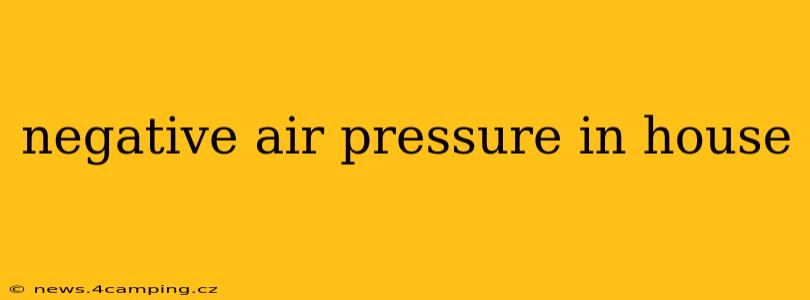Maintaining a healthy and comfortable home environment is crucial. One often-overlooked aspect is air pressure. While most homeowners are familiar with the concept of positive air pressure, understanding negative air pressure is equally important for ensuring a safe and energy-efficient home. This comprehensive guide will explore the causes, concerns, and solutions related to negative air pressure in your house.
What is Negative Air Pressure in a House?
Negative air pressure occurs when the air pressure inside your house is lower than the air pressure outside. This pressure imbalance can lead to various problems, impacting both the comfort and structural integrity of your home. Imagine a vacuum cleaner – it creates negative pressure to suck in air and debris. A house with negative pressure is similarly drawing air inward, but from potentially undesirable sources.
What Causes Negative Air Pressure in a House?
Several factors can contribute to negative air pressure within a home:
Powerful Exhaust Fans:
Exhaust fans in bathrooms, kitchens, and laundry rooms are designed to remove moisture and odors. However, if these fans are excessively powerful or run continuously without sufficient fresh air intake, they can create a negative pressure environment. This is especially true in tightly sealed, energy-efficient homes.
Leaky Ductwork:
A significant contributor to negative pressure is leaky ductwork. If your HVAC system's ductwork has holes or gaps, air is lost to the attic or crawlspace, leading to a pressure imbalance. This leakage often goes unnoticed but significantly affects air pressure. This is exacerbated by powerful HVAC systems that draw a large volume of air.
Air Sealing Issues:
Poorly sealed windows, doors, and other openings around the house allow air to escape, creating a negative pressure situation. This is particularly problematic during colder months when the pressure differential between inside and outside is at its greatest.
High-Powered HVAC Systems:
While designed to improve comfort, high-powered HVAC systems can unintentionally induce negative pressure if there isn't enough fresh air intake to replace the air being extracted.
What are the Problems Associated with Negative Air Pressure?
Negative air pressure in your home presents several potential issues:
Backdrafting:
This is perhaps the most serious concern. Negative pressure can cause the backdrafting of gases from appliances like furnaces, water heaters, and fireplaces. These gases, including carbon monoxide, can be deadly if they enter your living spaces.
Increased Energy Costs:
The constant inflow of outside air necessitates your HVAC system working harder to maintain a comfortable temperature, leading to increased energy consumption and higher bills.
Pest Infestation:
Negative pressure can draw insects and rodents into your home through cracks and gaps in the building envelope, seeking the lower pressure zone inside.
Dryness:
The continuous inflow of dry outside air can contribute to dry indoor air, leading to discomfort, dry skin, and damage to wood furnishings.
Uncomfortable Drafts:
Air rushing into the house to equalize pressure can create uncomfortable drafts around windows and doors.
How Can I Fix Negative Air Pressure in My Home?
Addressing negative air pressure requires a multifaceted approach:
Improve Air Sealing:
Caulk and weatherstrip all gaps and cracks around windows, doors, and other openings. Consider using expanding foam sealant for larger gaps.
Repair Leaky Ductwork:
Seal any leaks in your HVAC ductwork to prevent air loss. Professional duct sealing is often recommended for best results.
Install Air Intake Vents:
Incorporating fresh air intake vents (or ensuring existing ones function correctly) can provide a balanced supply of fresh air, mitigating the negative pressure created by exhaust fans and the HVAC system. Consider using energy recovery ventilators (ERVs) or heat recovery ventilators (HRVs) for efficient air exchange.
Reduce Exhaust Fan Run Time:
Limit the run time of bathroom, kitchen, and laundry room exhaust fans. Using timers or humidity sensors can help optimize their operation.
HVAC System Assessment:
Consider having a qualified HVAC technician assess your system to ensure it's appropriately sized and functioning correctly. An oversized system can exacerbate negative air pressure issues.
Frequently Asked Questions (FAQ)
How do I know if I have negative air pressure in my house?
Several indicators suggest negative air pressure, such as strong drafts around doors and windows, flickering flames in gas appliances, and a whistling sound around gaps. A professional inspection can definitively confirm negative air pressure.
Is negative air pressure dangerous?
Yes, negative air pressure can be dangerous due to the risk of backdrafting harmful gases, particularly carbon monoxide. It can also lead to increased energy bills and pest infestations.
How much does it cost to fix negative air pressure?
The cost varies depending on the extent of the problem and the necessary repairs. Minor sealing might be inexpensive, while significant ductwork repairs or HVAC system adjustments could be more costly. Getting multiple quotes from qualified professionals is always recommended.
Can I fix negative air pressure myself?
Some minor fixes like caulking and weatherstripping can be done by a homeowner, but more complex repairs, like ductwork sealing or HVAC adjustments, should be left to qualified professionals.
By addressing the underlying causes and implementing the solutions outlined above, you can effectively mitigate negative air pressure in your home, ensuring a healthier, more comfortable, and energy-efficient living environment. Remember that prevention is key; regular maintenance and proactive sealing can prevent many pressure-related problems from arising.
